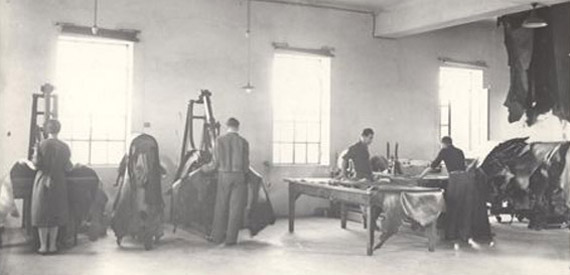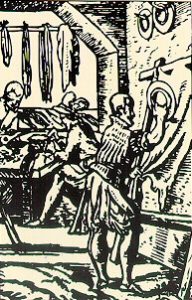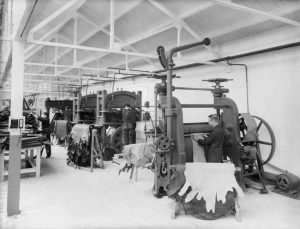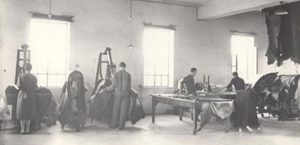
Early humans were forced to hunt animals in order to survive. The skin also has a special place. Because of this animal skin has been the best means of covering human beings to prevent various dangers. This type of skin use can be attributed to the Ice Age (with a history of five hundred thousand years ago).
Early humans used bones and sharp stones to remove excess flesh and skin lesions. But he soon realized the rapid decay of this type of skin against a variety of germs and bacteria. Later he tried to dry the skin in the sun or fire. Which again results in brittle and unusable skin? Until he finally realized the benefits of herbal extracts to prevent skin decay.

The ancient Egyptians used flour-based mineral compounds such as aluminum salts and mazo grains to make leather from about 2,500 BC. The Greeks and Romans used the bark and leaves of pine and spruce trees.
Due to this very important point, the history of the leather industry has evolved over a very long period of time and has gone through many experiences. From ancient times the skin has been used as one of the handicrafts of human skill and has been praised.
The raw materials of the skin were easily available to hunters of the land who had not yet begun the agricultural period and who needed horses in terms of environmental conditions. Their intense needs caused the skin to soften in such a way that in addition to being dry, it also had sufficient resistance against corruption after being wet many times.

Archaeologists still do not have a clear history of the early steps taken by early humans to transform the skin, other than evidence of smoking by rubbing oil and animal marrow into the skin and making very raw leathers.
Of course, different operations and works that were done on the skin in different ways and improved its softness and better application could also be considered as complementary aspects. The cavemen paid special attention to their religious beliefs about animals and their skin, as well as the final shape of the product made of skin.
The 10th to 12th centuries AD should be considered the history of centuries of leather making developments. Because in this period, the leather industry due to the advancement of technology in European countries (including the United Kingdom) was able to bring many commercial resources,

In the middle Ages, when industrial groups were gradually formed, the tannery community also emerged and various types of leather were classified for various uses. From the seventeenth century onwards, due to the great need of the people for leather products, this industry was introduced to the people in a new, important and wide way, and many operations were created to speed up the work in the leather industry. Most importantly, experienced and knowledgeable people entered the field of this industry and today universities with graduates
In the field of leather industry in all parts of the world are active in promoting this industry and various information and reports are published by various organizations and institutions to provide the latest technical information, statistics and which shows the importance and progress of this industry in recent centuries. animal skin
In the history of Iran, the use of different types of leather and leather has long been common and has been used for various purposes.
In our country, the basic methods for transforming the skin into a substance that is more resistant to various factors were gradually discovered, and through this, a material more resistant than ordinary skin was obtained. Among the basic methods in this case, the history of the skin can be mentioned: smoking the skin, rubbing oil and using alum, and so on.
After it was possible to turn leather into leather, its use expanded, and leather, in addition to previous uses such as body coverings, undergarments, tent making, water transportation, and other liquids such as milk and two in muskets made from animal skins. , Was used to prepare all kinds of inscriptions, flags, accessories and military clothing.
The emergence of skin-to-leather methods was in fact a huge change that made it possible to use the skin as a non-perishable and non-degradable material and due to the various uses that exist for the skin and the amount of these uses is increasing day by day.
Leather was bought and sold as a valuable substance. And since the Safavid era, the export of leather to countries such as Russia and the Ottoman Empire has begun on a large scale and every year, leather has formed a significant percentage of our country’s exports.

A few years after the fall of the Qajar dynasty, the city of Tabriz witnessed the development of western technology in the field of leather making. The first machine factory with new methods and using different sciences was established in 1308 AH in Tabriz called “Iran Leather Making” and later “Khosravi Leather” started as a modern unit in 1310 AH in Tabriz with 600 workers. And with the establishment of “Ardeshir Yeganegi” leather factory in Hamedan and Joint Stock Company in Tehran, other industrial factories in Tehran and Tabriz started working. animal skin
The first Iranian salambour factory in Tabriz, named “Wahabzadeh salambour factory” was established in 1315 (before the World War) by Mr. “Vahabzadeh” and with the expertise of a Greek specialist named “Galif Roli”.
Lack of need for complex and expensive machines and the abundance and cheapness of the most important raw material for salambour making, i.e. light skin, led to the emergence of numerous salambour making factories. Everyone found a piece of land and built a four-walled one, digging a pond and using a drum to start building a salamander.
Over time, during the years 1330 to 1350, several other factories were built in Iran, most of which were traditional and without sufficient expertise, based only on foreign notes and instructions and using inherited experience, and the idea of creating light leather factories due to new coatings. In 1315, light leather was given (salambour) did not appear in public opinion and did not take shape until in 1350, the first independent light leather factory called National Leather was established and started operating.
Two years later, in 1973, the Industrial Development and Renovation Organization of Iran was commissioned to implement projects in the field of light leather in different parts of the country. animal skin
The organization created a company called Iran Leather and Leather Industries Company and with the cooperation of a group of consulting engineers to build several factories in different parts of the country, including Khorasan and Lorestan, and while trying to implement other projects in this field, did not move. .
Also, after 1352 and by the Agricultural Development Bank, two light leather projects were implemented in Shiraz (Charmineh) and Ardabil (Moghan leather) and also next to this project, a special factory for making fur and clothing from it in Mazandaran province called Fur coats were created that were able to turn some of the inner skins into leather.
After the victory of the Islamic Revolution and since 1979, the idea of creating light leather factories was more formed and many projects were reviewed by the IRI Ministry of Industry. animal skin
It is worth mentioning that with the development of the history of leather industry, the way of making leather in Iran has changed and leather making has been introduced in an advanced and industrial form and modernized and advanced factories have been established in this field.
However, the formation of modern and newly established factories is mostly based on the use of heavy skins as a raw material and the production of cowhide and cumin leathers. Have formed heavy skins and these factories have been active in the production of heavy leathers and in these designs very little attention has been paid to the existing skins of the country and especially the amount of light skins of the country has not been considered at all.
It should be noted that the number of light livestock in the country is much higher than heavy livestock and finally the number of light skins resulting from annual slaughter is much more than domestic heavy and light skins have a higher figure than heavy. animal skin

Light leather is produced in many countries, but what is different in different countries is the history and quality of the skin, and this means that the high quality of our sheepskin is one of the reasons for its worldwide fame. Sheepskin in Iran has a very high history and quality and has high cohesion and strength. This type of leather is mainly used in the production of leather.
But only the initial stages of its recruitment, i.e. the dirtiest and most laborious stage, are done in Iran, and after this stage, Salambour is obtained which is graded by experts (Sourt Chi) in terms of quality and exported abroad. .
In recent years, the production of other types of animal skins has begun, which can be referred to ostrich leather, which in recent years has become popular leather among the people. animal skin
A reconstructed video from the history of leather making in the past